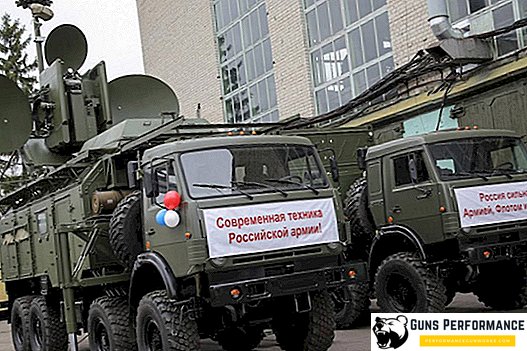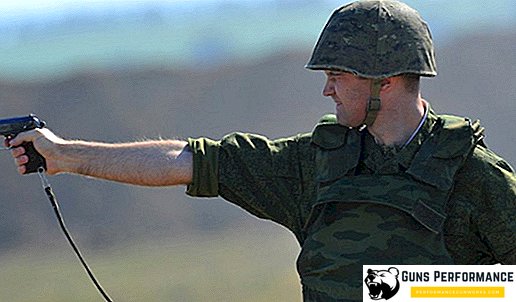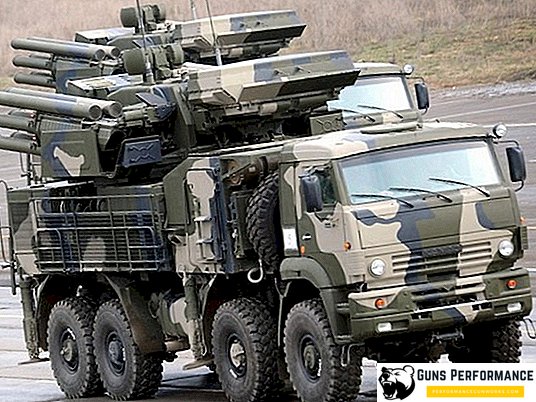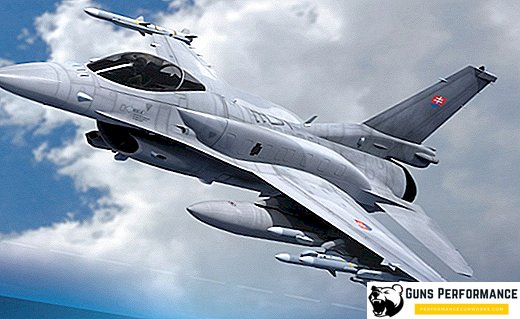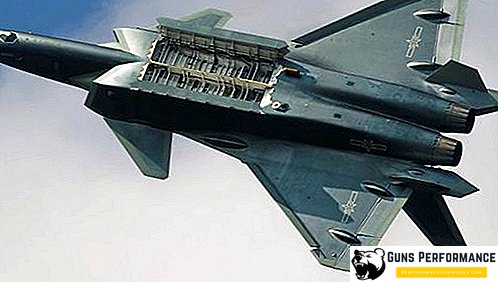
The Antey Project 949A submarine cruisers are a third-generation nuclear submarine (APL) series armed with Granit anti-ship cruise missiles, which were designed in the early 80s in the Rubin Design Bureau. Project 949A submarines, in fact, are an upgraded version of the ships of the project 949 Granit, work on which began in the late 60s. The main objective of these submarine cruisers is the destruction of enemy carrier strike groups.
The first submarine of the project 949A was adopted by the USSR Navy in 1986. A total of eleven submarines of this series were built, eight of which are currently serving in the Russian Navy. Another submarine is in conservation. Each of the "Anteyev" is named after one of the Russian cities: Irkutsk, Voronezh, Smolensk, Chelyabinsk, Tver, Oryol, Omsk and Tomsk.
One of the most tragic pages in the modern history of the Russian fleet is connected with submarines of project 949A. In August 2000, in the Barents Sea, along with the crew, the submarine Kurs was killed. The official reasons for this catastrophe still raise many questions.
One of the main tasks that faced the Soviet navy after the end of the Second World War, was the fight against American aircraft carrier groups. Project 949A "Antey" became the pinnacle of the development of highly specialized submarine cruisers - "killers" of aircraft carriers.
The cost of a single submarine "Antey" was 226 million Soviet rubles (mid-80s), which is ten times less than the cost of an American aircraft carrier of the Nimitz type.

History of creation
At the end of the 1960s, the development of two projects, inextricably linked, began in the USSR In OKB-52, work began on the creation of a new long-range missile anti-ship complex, which could be used against powerful enemy ship groups. First of all, it was about the destruction of the American aircraft carriers.
Around the same time, the Rubin Central Design Bureau started the construction of a third generation submarine missile carrier, which would become the carrier for the new missile complex and replace the outdated Project 675 submarines.
The military needed a powerful and effective means capable of hitting enemy ships at considerable distances and a submarine with greater speed, secrecy and depth of immersion.
In 1969, the Navy prepared an official task to develop a new submarine, the project received the designation "Granit" and the number 949. Also, the requirements of the military regarding the new anti-ship missile were formulated. They had to have a range of at least 500 km, a high speed (not less than 2500 km / h), to start both from the underwater and from the surface position. This rocket was planned to be used not only for arming submarines, but also for surface ships. In addition, the military was very interested in the possibility of salvo firing - it was believed that the "flock" of twenty missiles had a greater chance of penetrating the airborne warfare of an aircraft carrier warrant.

However, the effectiveness of long-range anti-ship missiles was determined not only by their speed and mass of the warhead. A reliable system of target designation and reconnaissance was needed: first, the enemy had to be found in the vast ocean.
The Success system at that time, which used Tu-95 aircraft, was far from perfect, so the Soviet military-industrial complex was tasked with creating the world's first space system for searching for and observing surface objects. Such a system had a number of advantages: it did not depend on the weather, could collect information about the situation on vast areas of the water surface, was practically inaccessible to the enemy. The military demanded that target designation be issued directly to carriers of weapons or command posts.
OKB-52 under the direction of V.N. Chelomey became the head organization responsible for the development of the system. In 1978, this system was adopted. She received the designation "Legend".
In the same year, the first submarine of Project 949 - K-525 “Arkhangelsk” was launched, in 1980 she was commissioned in the fleet, in 1983 the second ship of this project, the submarine K-206 “Murmansk”, entered service. The construction of submarines was carried out at the "Northern Machine-Building Enterprise".
At the end of 1975, tests began on the main weapons of these submarine cruisers, the P-700 Granit missile system. They were successfully completed in August 1983.
Further construction of submarines went on an improved project 949A "Antey". Another compartment appeared on the upgraded submarines, which improved its internal layout, the length of the ship increased, its displacement increased. More sophisticated equipment was installed on the submarine, the developers managed to increase the ship's secrecy.
It was originally planned to build twenty nuclear submarines under the Antey project, but the collapse of the Soviet Union corrected these plans. A total of eleven ships were built, two boats, the K-148 Krasnodar and the K-173 Krasnoyarsk, were disposed of or are in the process of recycling. Another submarine of this project, the K-141 Kursk, died in August 2000. Currently, the Russian fleet includes: K-119 Voronezh, K-132 Irkutsk, K-410 Smolensk, K-456 Tver, K-442 Chelyabinsk, K-266 Orel , K-186 Omsk and K-150 Tomsk.
The completion of another submarine of this project, the K-139 Belgorod, will be continued on a more perfect project - 09852. Another submarine of the Antey type, the K-135 Volgograd, in 1998 was mothballed.

Description of construction
The submarines of the project "Antey" are made according to the two-body scheme: the internal strong hull is surrounded by a light external hydrodynamic hull. The stern part of the vessel with plumage and propeller shafts in general resembles the submarine of project 661
The two-part architecture has a number of advantages: it provides the ship with an excellent reserve of buoyancy and enhances its protection against underwater explosions, but at the same time significantly increases the displacement of the ship. The submarine displacement of the submarine of this project is about 24 thousand tons, of which about 10 thousand is water.
The robust hull of the submarine cruiser has a cylindrical shape, its wall thickness is from 48 to 65 mm.

The case is divided into ten compartments:
- torpedo;
- management;
- combat posts and radio room;
- Living spaces;
- electrical equipment and auxiliary mechanisms;
- supporting mechanisms;
- reactor;
- GTSA;
- rowing motors.
The ship has two areas for the rescue of the crew: in the bow, where the pop-up camera is located and in the stern.
The number of crew of the submarine is 130 people (according to other information - 112), the autonomy of the vessel’s navigation is 120 days.
The Antey underwater cruiser has two OK-650B water-to-water reactors and two steam turbines that rotate propellers through gears. The ship is also equipped with two turbo-generators, two diesel generators DG-190 (800 kW each) and two thrusters.
The submarines of the Antey project are equipped with the MGK-540 Skat-3 hydroacoustic complex, as well as with space reconnaissance and target designation and command and control systems. Information from a satellite system or from aircraft a cruiser can receive underwater using special antennas. The boat also has a towed antenna, which is produced from a pipe located on the aft stabilizer.

On the submarines 949A installed navigation system "Symphony-U", which is characterized by high accuracy, large radius of action and can process a significant amount of information.
The main type of weapons submarines are anti-ship missiles (ASM) P-700 "Granit". Rocket containers are located on both sides of the wheelhouse, outside the strong hull of the boat. Each of them has a slope of 40 °. The missile can carry a conventional (weighing 750 kg) or a nuclear warhead (500 Kt). The firing range is 550 km, the rocket speed - 2.5 m / s.

The submarine cruiser can lead as a single fire, and launch the anti-ship missiles in one gulp, launching up to 24 missiles at a time. PKR "Granit" have a complex trajectory, as well as good noise immunity, which makes them a serious threat to any opponent. If we talk about the defeat of the carrier order, then the likelihood of this is especially high when salvo firing. It is believed that for the sinking of an aircraft carrier nine Granites must get into it, but even one accurate shot is enough to prevent planes from taking off from its deck.

In addition to missiles, submarines project 949A "Antey" have at their disposal and torpedoes. Submarines have four torpedo tubes with a caliber of 533 mm and two - 650 mm. In addition to conventional torpedoes, you can shoot rocket-torpedoes from them. Torpedo tubes are located in the bow of the ship. They are equipped with an automatic loader, so they have a high rate of fire - all ammunition can be released in just a few minutes.
NPS project "Antey"
Below is a list of all submarines of this project:
- Krasnodar. Disposed of at the Nerpa plant.
- "Krasnoyarsk". It is in the process of being dismantled, its name has already been assigned to another submarine of the project 885.
- "Irkutsk". Currently, it is under repair and modernization under the project 949AM. It is part of the Pacific Fleet.
- "Voronezh". It is in the composition of the Northern Fleet.
- "Smolensk". Included in the combat of the Northern Fleet.
- "Chelyabinsk". It is part of the Pacific Fleet. Currently, it is under repair and modernization under the project 949AM.
- "Tver". It is in the composition of the Pacific Fleet.
- "Eagle". Is on the repair, which should be completed this year.
- "Omsk". Included in the combat fleet of the Pacific Fleet.
- "Kursk". She died in the Barents Sea on August 12, 2000.
- "Tomsk". It is part of the Pacific Fleet, currently under repair.

Project Evaluation
In order to assess the effectiveness of the Antey submarines, one should first of all pay attention to the main weapon of these submarine cruisers, the PKR P-700 Granit.
Developed back in the 80s of the last century, today this complex is clearly outdated. Neither the range of this rocket, nor its noise immunity meet the modern requirements. And the elementary base on which this complex was created, has long been outdated.
In 2011, it was announced that the specialists of the TsBB Rubin developed a project for the modernization of the submarines of this project. First of all, it concerns cruiser missiles. Containers for PKR "Granit" will be replaced by launchers, from which you can shoot modern "Onyx" and "Caliber." This will turn the "Anthea" into a universal tool capable of solving various tasks.

Specifications
The following are the characteristics of the project 949A submarine:
- displacement overhead., cubic meter - 12,500;
- displacement basement, cubic meter - 22,500;
- power plant - 2 × OK-650 (with a power of 2 x 190 MV);
- surface speed, knots - 15;
- underwater speed, knots - 32;
- Max. immersion depth, m - 600;
- autonomy, days - 120;
- crew, people - 94;
- Armament - 24 PKR "Granit", TA 650 mm - 4 pcs., TA 533 mm - 4 pcs.


